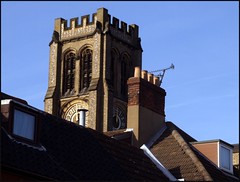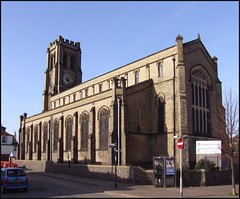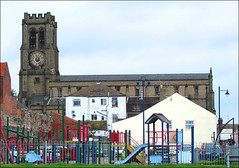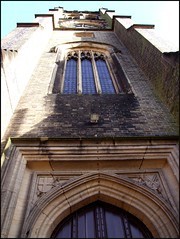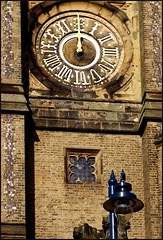| |
|
St
Spyridon, Great Yarmouth
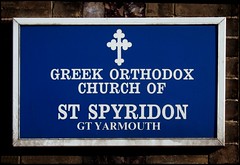 |
|
It
is the lot of a few churches to be instantly
recognisable, and there is nothing else in East
Anglia quite like the great bulk of St Spyridon.
The white brick with flint panelling, the narrow
hunched aisles and the great soaring tower, the
curious clock, would have fingers reaching for
the buttons immediately on any quiz about
Norfolk's urban churches. Its setting in the low
Victorian terraced streets of south Yarmouth, a
short walk from the sea front, makes it seem even
more imposing. As the region's largest
seaside town, it is not surprising that a
relatively large percentage of Great Yarmouth's
population is Greek in origin. Indeed, it is
probably East Anglia's largest Greek community
outside of Cambridge and Norwich. Many of those
here are Greek Cypriots, who came to England
during the war and fascist dictatorship of the
early 1970s to join an already established
community working in the restaurant trade and
other service industries. St Spyridon is the
community's Orthodox church, one of barely half a
dozen Orthodox churches in Norfolk.
|
This was
the Anglican parish church of St Peter originally, and
the building's jaunty character is a consequence of its
construction in the early 1830s; it is, in fact, a
Georgian church, and was built before the rows of
terraced houses were laid out around it. The architect
was that prolific Yarmouth church builder JJ Scoles, and
this was an early work of his. He was also responsible
for the rather more ecclesiologically correct Catholic
church of St Mary a short walk away, as well as the
charming church of St Mary in Southtown. Three very
different churches built over a period of less than
twenty years, suggesting that Mr Scoles was an adaptable
chap.
There is a
concentration of 19th century churches in south Yarmouth,
and it is not surprising that almost all of them have now
been declared redundant. St Peter was the first to go,
falling out of use in the 1960s. The Greek community were
in possession by 1964, and the dedication plaque above
the west door records that the building was formally
dedicated in April 1983. It is a large structure, its
nave and tower lifting forcefully and creating an
impression of height, but it is not a wide church. If the
aisles seem perfunctory it is because they were intended
to accomodate a gallery, which runs around three sides of
the interior. This is a reminder that the building
predates the Oxford Movement's successful attempt to
restore sacramentalism to the Church of England, and that
first and foremost St Peter was built and intended as a
preaching house. Pevsner declared the church large
and uncommonly dull, noting that it was built
through the aid of the second parliamentary grant at a
cost of £7,735, about one and a half million pounds in
today's money. Over the next decades the starkness of the
building was ameliorated somewhat by the insertion of
some very good glass, some by the Kempe workshop.
Intriguingly, the tower had pinnacles, but they were
removed as dangerous as early as 1860.
The
interior of the present-day church is still large, but it
is certainly not uncommonly dull. It is full of the
colour and vigour of the Greek Orthodox Church. Most
strikingly, of course, the altar and sanctuary are
screened by a vast iconostasis painted with Saints. It
must surely predate the 1960s in construction, and must
have been brought here from elsewhere.
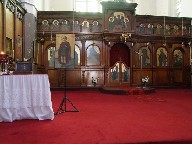 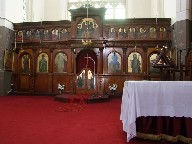 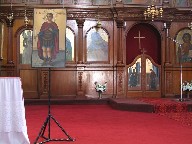
Rather
startlingly, the arcades have been filled in on both
sides of the nave to create rooms under the galleries.
Above, these are screened off rather unsatisfactorily
with blue plastic sheeting, presumably a temporary
measure. On the walls of the infill, to north and south,
are dozens of large icons of Saints. It is a beautiful
place to wander, despite the plastic sheeting.
| I
came here on Heritage Open Day, and the man on
duty was very welcoming, explaining to me that
the building took a lot of looking after as it
was a hundred years old - in fact, it is now
nearly two hundred. He was happy for me to take
photographs, which has never been my experience
in an Orthodox church before as photography is
generally considered disrespectful to the icons.
As I wandered about, there was a constant flow of
people in and out of the building, visiting the
church office and other meeting rooms along the
arcades. It felt like a busy, happy community. Nineteenth
century churches declared redundant in the 1960s
did not generally suffer the same happy fate as
this one. Many were demolished, including two a
few miles off in Lowestoft. Incredibly, the
wonderful and nationally significant Arts and
Crafts church of All Saints in central Cambridge
was granted a demolition order before being
rescued by conservationists and campaigners. All
Saints stands empty today, a museum piece: but,
thanks to the lively Greek community of Great
Yarmouth, St Spyridon is full of life.
|
|
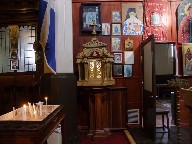 |
|
|
|

